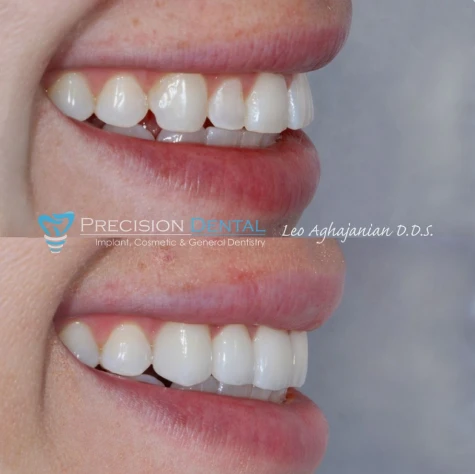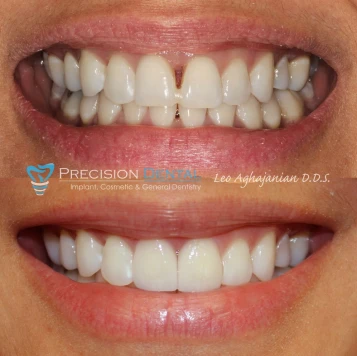Frequently Asked Questions
Our Glendale dentist and staff are committed to providing you with comprehensive dental service. Below you will find the answers to some of our patient's most frequently asked questions. However, if you do not find the answer you are looking for, please do not hesitate to contact our Glendale dental office.
Patient Information
We accept cash, Visa and Mastercard payments.
We accept all PPO insurances.
If you don't have insurance, we offer discounted pricing for students and seniors and will work with you to make payments within your budget. See our dental specials.
Yes, we provide emergency dental care and accept walk-ins.
We will need your full name, insurance information if you have any and a contact phone number.
Yes, we offer a 10% discount for seniors.
Yes, we offer 0% financing through CareCredit.
No.
Yes, we see children of all ages. In fact, your child should have his or her first dental visit by the age of 1 in order to establish good hygiene habits, ensure good oral health and educate parents on home care.
Your dental visit costs are determined by multiple factors such as insurance benefits, co-payments, and the procedure of the visit. For patients that don't have insurance the prices will be determined by the office fee schedule. Call us (818)545-8923 so that we may answer your questions directly.
Discounts of 5% are given for payments made in full and in advance.
No, you can have any treatment done, however, if the procedure is not covered by your insurance company, you will be responsible for payment.
If your child is able to sit through a dental visit without behavioral trouble, there is no need to see a specialist. However, children that are highly dental phobic might require alternative methods of treatment which the pedodontist ( children's dentist specialist) is specially trained to take care of.
Our last procedural appointments start at 5pm.
You can get started ASAP. Please give us a call at (818) 545-8923 to schedule an appointment for your needs.
Precision Dental, the dental office of Dr. Leo Aghajanian DDS, is open Mondays, Tuesdays, Thursdays, and Fridays from 9 am to 6 pm, and closed on Wednesdays, Saturdays and Sundays.
Precision Dental, the dental office of Dr. Leo Aghajanian DDS, is located at 411 N. Central Avenue Suite 245. Glendale, CA, 91203.
Yes, we are taking new patients.
Children should start seeing the dentist from the age of 1 to establish a 'dental home'. Your child should have his or her first dental visit by the age of 1 in order to establish good hygiene habits, ensure good oral health and educate parents on home care.
Oral Health
You should visit your dentist at least twice a year at 6-month intervals, but sometimes more often in some circumstances.
Commonly bad breath is caused by volatile organic compounds released by the bacteria that live in our mouths in the following circumstances: overgrowth of bacteria on the tongue, infections of the gums, cavities, rotting food debris that accumulates between teeth that have spaces or uneven surfaces and in some cases can be the result of gastric reflux commonly known as 'heart burn' which involves stomach acid traveling back up the esophagus ( the food pipe) into the mouth. These are indicative of problems that exist in the mouth that can potentially lead to severe conditions which compromise one's quality of life. The good news is that all of these conditions are treatable.
You should floss and brush once in the morning, once before sleeping and after meals.
Generally, if you have healthy gums, you should have your teeth cleaned professionally every 6 months. With patients that have periodontal disease (gum and bone disease), the frequency may change to once every 3 months.
Although there are multiple methods of whitening, Dr. Aghajanian finds that take-home custom-made whitening trays with professional strength whitening gel give the most predictable results.
Gaps between teeth can be eliminated with three methods; orthodontics, veneers and dental crowns. Orthodontics involves braces or clear invisible aligners that move the teeth into the desired position to eliminate spaces. Veneers are made of porcelain and act as a new 'face/mask' for your tooth that can be used to close minor gaps. Crowns (caps) can also be used to address minor gaps between teeth, among other conditions such as decayed or fractured teeth. Sometimes a combination of these 3 techniques will need to be used in order to achieve the best results.
There is an important difference between how teeth whitening toothpastes work and professional teeth whitening works. Whitening toothpastes have aggressive sand-like particles that help remove the dark stains on your teeth to reveal the tooth surface underneath but they do not lighten the existing tooth surface itself. In contrast, professional custom made trays and whitening gels actually brighten the tooth surface itself. Over time the whitening toothpastes can wear the surfaces of your teeth prematurely, so be careful and use them sparingly, alternating with regular toothpastes.
More important than comparing manual vs. electric toothbrushes is the technique of brushing itself. Granted high-quality electric toothbrushes will make brushing easier and more efficient, but only if they are used correctly. The same results can be achieved with a manual toothbrush if you know the proper brushing technique. Dr. Aghajanian reviews proper brushing techniques with every new patient.
Tooth decay refers to the softening of tooth structure by the action of acids and the invasion of the inside of the tooth by bacteria. Tooth decay is bad because it leads to the weakening of the tooth that can give way to breakage of the tooth and potential life threatening infections. It is very important to have decay diagnosed properly and treated in a timely manner to avoid such complications.
Decay is caused by acids that come from 2 sources, one is directly from acidic foods or drinks that we consume, and the second is from acid produced by the bacteria that live in our mouth as a result of the sugars we consume in our diet. Fluoride helps reverse the damage done by acids, but only the superficial layer on the surface of our teeth called enamel. Once the decay is below the surface, fluoride can no longer help reverse the progression of the decay to deeper layers.
There is much debate on this subject. Silver fillings have been in use for over 100 years. It is true that mercury is approximately 50% of the silver filing, however, it is not in its elemental or salt forms which can be toxic, rather, it is bound in the alloy of metals. The official stand of the ADA is that amalgam fillings are indeed safe. There is no definitive scientific proof that silver fillings are harmful to one's health.
Crooked teeth can be straightened with Invisalign or braces.
Dental implants can be used to help a variety of patients of any age with different needs. Most people in good health are good candidates.
Candidates will be determined after a thorough review of health status.
Fillings, whether they be white or silver, are usually changed due to decay or fracture. At times silver fillings may be aesthetically unpleasant and may be replaced with a tooth-colored filling. However, not every silver filling should be replaced for the sake of color as this may lead to unnecessary removal of healthy tooth structure.
Whiter teeth can be achieved by first determining what the cause of the darkened shade of the teeth is and secondly addressing that cause. If there are stains due to foods or drinks such as wine, tea or cigarettes, then those teeth can be cleaned and brightened with whitening gel.
Coffee and wine stains can be removed with a dental cleaning and whitening combination. The staining is usually on the surface of the tooth and is not permanent. However, if you do have cracks or imperfections on the surfaces of your teeth, those can become permanently stained because there would be no way to get the stain out of a crack.
Multiple conditions can cause temperature sensitivity. Sometimes a tooth has decay (cavity) in it, which harbors bacteria that leads to irritation of the tooth's pulp which contains the nerves and blood vessels. An irritated pulp will have a more exaggerated response to cold foods or drinks. Another case can be gum recession which leads to exposed root surfaces. Root surfaces are porous and have microscopic channels that lead into the pulp that can conduct sensitivity. A third condition can be an uneven bite that leads to heavy loading forces on a particular tooth, which can cause much trauma to the nerve tissues leading into the pulp, and making the nerves hypersensitive. In any of these cases, the condition needs to be diagnosed and treated properly to alleviate the patient's pain.
The primary ingredient in toothpaste that is of the most benefit to your teeth is fluoride. Fluoride provides your teeth the anti-cavity protection. Whitening toothpaste can be very abrasive, so it should not be used for very long periods of time, otherwise it can wear the surface of the teeth down prematurely. My advice is to pick any fluoridated toothpaste you like.
Tooth-colored fillings and restorations are prescribed on a case-by-case basis. A proper diagnosis and your tooth will be needed to answer this question. However, to answer the question of risks, they are minimal. There is always the chance of having sensitivity after placing a tooth-colored filling as there is for any restoration. If the filling is too large the tooth may not be protected ideally and is more susceptible to fracturing or forming new cavities around the margins of the restoration.
Straighter teeth can be achieved by means of using Invisalign, conventional braces or, in some cases, crowns and veneers. Each mode of treatment is different and will take different periods of time depending on your situation with the orthodontic options taking the longest (anywere from 6 months to more than 2 years).
Keeping up with your regular dental visits every 6 months is the best way to prevent further breakdown of your teeth. In dentistry, prevention is key; there is an old saying, 'an ounce of prevention is worth a pound of cure'. Teeth can break down due to multiple conditions such as failing restorations, decay, habitual grinding/clenching, trauma etc. Therefore it is important to address these issues on a regular basis when things are small or easier to treat rather than wait for things to fall apart and then try to fix a complicated situation.
Fluoride toothpaste is important for healthy teeth, however, it is not recommended for children under the age of 2 for the primary reason that children of this age cannot spit the paste out of their mouths and end up swallowing instead. Ingestion of fluoride from toothpaste on a daily basis would be harmful to the developing teeth and bones. Therefore it is important to use fluoride-free toothpaste as a way to form good oral hygiene habits and then your child is able to spit the toothpaste out on command, then you can switch to fluoride toothpaste. Only a very small amount of paste ( enough to just 'paint' the tip of the bristles of the toothbrush ) should be used.
Teeth whitening is safe; there is no long-lasting permanent damage that can occur to your teeth from occasionally whitening them. Your teeth may become sensitive after whitening, which is normal. If your teeth become sensitive, you should reduce the duration of the whitening session or skip a few days to allow your teeth to recover. Sometimes if you get whitening gel on the gums, your gums will temporarily turn white and then return to their normal color. As with all things, whitening should not be done in excess, but only in moderation.
You can whiten your teeth at home with some over-the-counter products. However you will not achieve the same level of brightness as expected from professional custom-made trays and take-home whitening systems.
Replacing missing teeth with implants requires three components: implant, abutment and crown. Implants are titanium screws that replace the root portion of the missing teeth and the abutment is the component that is fastened onto the implant which supports the crown on top. Implants are placed inside the bone and require about 3 months for the bone to integrate with the implant surface before the restoration can be placed.
Because bad breath does not only come from teeth. Commonly, bad breath is caused by volatile organic compounds released by the bacteria that live in our mouths in the following circumstances: overgrowth of bacteria on the tongue, infections of the gums, cavities, rotting food debris that accumulates between teeth that have spaces or uneven surfaces and in some cases can be the result of gastric reflux commonly known as 'heart burn' which involves stomach acid traveling back up the esophagus ( the food pipe) into the mouth. These are indicative of problems that exist in the mouth that can potentially lead to severe conditions which compromise one's quality of life. The good news is that all of these conditions are treatable.
We offer oral conscious sedation which greatly reduces anxiety and places patients at ease.

What do I bring to my appointment?
CALL US!
(818) 545-8923








